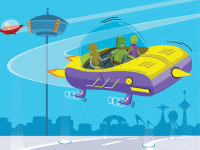The Classroom and the Cloud: A Bright Forecast for 2020
What will the classroom of 2020 look like? As I look ahead, many of the trends we're seeing today will continue to expand learning beyond the classroom walls to connect educators, students and real-world experiences. These trends are being driven by pioneering teachers and their students, and are fueled by technology -- especially the Internet and the cloud. With more than 40 states adopting Common Core and with increased focus on deeper learning and developing creativity, I see exciting movement to a more personalized and collaborative education. Together with the proliferation of devices such as smartphones and tablets, teachers and students will have unprecedented access to tools for creative expression, and will find it even easier to share, to co-create and to experiment with new ideas.
Community in the Cloud
Today, teachers are leading the way and spearheading change. They are building rich global online communities using digital media and taking advantage of the Internet and the growing presence of the cloud. According to Marion Ginapolis, Public Schools Superintendent for Lake Orion, Michigan, "It's not about technology; it's about sharing knowledge and information, communicating efficiently, building learning communities and creating a culture of professionalism in schools."
Pete Episcopo is a great example. He is a course director at Full Sail University in Winter Park, Florida, and was lead teacher in the development and operation of the Academy for Digital Arts & Media (ADAM) in Viera, Florida.
In his interview in You The Designer, Episcopo observed that the growing online environment has provided the opportunity to collaborate with colleagues, friends and fellow creatives around the world. "It has afforded us the opportunity to share, announce, display or request feedback for our work," he said. "As an educator, I'm always trying to build a sense of community in my courses. I also encourage students to continue building that community beyond the classroom."
The ease of access afforded by the cloud is making such communities possible, and it will influence how students learn, network and share with others. By 2020, more personalized online learning resources will be available for students to use both in the classroom and at home, on multiple device types. Students will be creators of digital content, and the cloud will facilitate collaboration and communication beyond the classroom walls.
Increased Emphasis on Digital Portfolios
By 2020, students will demonstrate their creativity, skills and knowledge in ways that take advantage of the technology available to them. In particular, expect to see greater reliance on student portfolios and an expansion of the ways that the education community and employers assess students.
Students will increasingly use digital portfolios to demonstrate their skills and knowledge as they apply for college and jobs. What's more, these digital portfolios will serve as platforms for collaboration and feedback from members of their communities. Looking to 2020, digital portfolios accessible from multiple devices will make it easier for students to demonstrate real-world skills and knowledge, and will serve as a stronger link to their next steps professionally and educationally. I expect changes in how we evaluate student work with a decreased dependency on transcripts and a greater emphasis on a body of work.
Improved Student Engagement
It's old news that we are facing a crisis in fully developing students' science, technology, engineering and math skills. But forward-thinking teachers are experimenting with ways to teach problem solving and creativity, as well as STEM skills.
For example, David Conover, a digital interactive media and video game design instructor at John B. Connally High School in Austin, Texas, has been exploring game design for the past four years through the school's STEAM Video Game Program. (The program also emphasizes the arts, hence the "A" in STEAM). With a focus on student success and engagement via interactive, game-based classroom activities, students tackle a real-world problem from a client and are tasked with developing possible solutions. "Game-based learning demonstrates team values and student-driven solutions that teachers around the U.S. can adapt in their own classrooms and lesson plans," said Conover. "The end goal is for students to create a finished game and then feel confident in pursuing a job opportunity or going on to higher education."
Conover’s program is one example of how game-based learning -- as well as other innovative technologies, such as mobile learning, analytics, 3D printing and even virtual laboratories -- inspires leadership, creativity and innovation among students and educators. By 2020, more students will engage in learning and will develop their skills, knowledge and competencies in real-world settings.
It's safe to say that the cloud will increase connections and support a broader range of learning, creative thinking and expression. Further, remote learning techniques and other innovative technologies will allow teachers to better engage with students both in and out of the classroom.
Nevertheless, excellent teaching remains at the heart of student success. It is imperative that educators continue to explore and experiment with new technologies -- and share best practices -- to support positive learning outcomes and successfully propel students in 2020 and beyond.
